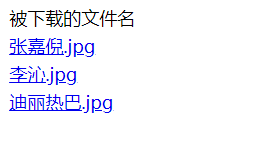一、传统方式的文件上传
(1)引入jar包
<dependency>
<groupId>commons-io</groupId>
<artifactId>commons-io</artifactId>
<version>1.2</version>
</dependency>
<dependency>
<groupId>commons-fileupload</groupId>
<artifactId>commons-fileupload</artifactId>
<version>1.3.1</version>
</dependency>(2)在index.jsp编写文件上传的表单
<%@ page contentType="text/html;charset=UTF-8" language="java" %>
<html>
<head>
<title>Title</title>
</head>
<body>
<h3>传统方式文件上传</h3>
<form method="post" action="${pageContext.request.contextPath }/user/uploadFile01" enctype="multipart/form-data">
选择文件:<input type="file" name="upload"><br>
<input type="submit" value="上传">
</form>
</body>
</html>
注意:
a.标签 <input type="file"/> 会在浏览器中显示一个输入框和一个按钮,输入框可供用户填写本地文件的文件名和路径名,按钮可以让浏览器打开一个文件选择框供用户选择文件。
b.表单的 enctype 属性指定的是表单数据的编码方式,该属性有以下 3 个值。
- application/x-www-form-urlencoded:这是默认的编码方式,它只处理表单域里的 value 属性值。
- multipart/form-data:该编码方式以二进制流的方式来处理表单数据,并将文件域指定文件的内容封装到请求参数里。
- text/plain:该编码方式只有当表单的 action 属性为“mailto:”URL 的形式时才使用,主要适用于直接通过表单发送邮件的方式。
(3)在UserConrtoller添加方法。
@RequestMapping("/uploadFile01")
public String uploadFile01(HttpServletRequest request) throws Exception {
System.out.println("传统方式文件上传");
//文件上传的位置
String path = request.getSession().getServletContext().getRealPath("/uploads");
File file = new File(path);
//文件夹不存在则创建文件夹
if(!file.exists()){
file.mkdirs();
}
//解析request对象,获取文件上传项
DiskFileItemFactory fileItemFactory = new DiskFileItemFactory();
ServletFileUpload upload = new ServletFileUpload(fileItemFactory);
List<FileItem> items = upload.parseRequest(request);
for(FileItem item : items){
//判断当前item对象是否为文件上传项
if(!item.isFormField()){
//获取文件名称
String fileName = item.getName();
String uuid = UUID.randomUUID().toString().replace("-","");
fileName = uuid + "_" + fileName;
//完成文件上传
item.write(new File(path, fileName));
//删除临时文件
item.delete();
}
}
return "success";
}(4)在WEB-INF下创建pages目录,建立success.jsp文件
<%@ page contentType="text/html;charset=UTF-8" language="java" %>
<html>
<head>
<title>Title</title>
</head>
<body>
<h3>文件上传成功</h3>
</body>
</html>
(5)启动项目,选择文件,进行上传测试。

二、Spring MVC实现单文件上传
Spring MVC 框架中上传文件时将文件相关信息及操作封装到 MultipartFile 对象中,因此只需要使用 MultipartFile 类即可完成文件上传的操作。
(1)在index.jsp中添加表单。
<h3>Spring MVC方式文件上传</h3>
<form method="post" action="${pageContext.request.contextPath }/user/uploadFile02" enctype="multipart/form-data">
选择文件:<input type="file" name="upload"><br>
<input type="submit" value="上传">
</form>(2)在web.xml中配置MultipartResolver,用于上传文件。
<!-- 配置文件解析器对象,要求id名必须为 multipartResolver -->
<bean id="multipartResolver" class="org.springframework.web.multipart.commons.CommonsMultipartResolver"></bean>(3)添加处理的方法。
@RequestMapping("/uploadFile02")
public String uploadFile02(HttpServletRequest request, MultipartFile upload) throws Exception {
System.out.println("Spring MVC方式文件上传");
//获取文件上传的位置
String path = request.getSession().getServletContext().getRealPath("/uploads");
File file = new File(path);
//文件夹不存在则创建文件夹
if(!file.exists()){
file.mkdirs();
}
//获取要上传的文件的名称
String fileName = upload.getOriginalFilename();
String uuid = UUID.randomUUID().toString().replace("-", "");
fileName = uuid + "_" + fileName;
upload.transferTo(new File(file, fileName));
return "success";
}(4)启动项目,选择文件,进行上传测试.

需要注意的是
a.表单中file标签的name属性名称必须和入参的变量名称相同,如下:

b. 配置文件解析器对象,要求id名必须为 multipartResolver
三、Spring MVC实现多文件上传
(1)在index.jsp中添加表单。
<h3>Spring MVC多文件上传</h3>
<form action="${pageContext.request.contextPath }/user/multiFileUpload"
method="post" enctype="multipart/form-data">
选择文件1:<input type="file" name="myFile"><br>
文件描述1:<input type="text" name="description"><br />
选择文件2:<input type="file" name="myFile"><br>
文件描述2:<input type="text" name="description"><br />
选择文件3:<input type="file" name="myFile"><br>
文件描述3:<input type="text" name="description"><br />
<input type="submit" value="提交">
</form>(2)添加pojo类。
public class MultiFileMsg {
private List<String> description;
private List<MultipartFile> myFile;
public List<String> getDescription() {
return description;
}
public void setDescription(List<String> description) {
this.description = description;
}
public List<MultipartFile> getMyFile() {
return myFile;
}
public void setMyFile(List<MultipartFile> myFile) {
this.myFile = myFile;
}
@Override
public String toString() {
return "MultiFileMsg{" +
"description=" + description +
", myFile=" + myFile +
'}';
}
}
(3)添加处理方法
@RequestMapping("/multiFileUpload")
public String multiFileUpload(HttpServletRequest request, @ModelAttribute MultiFileMsg multiFileMsg) throws Exception {
System.out.println("Spring MVC多文件上传");
//获取文件上传的位置
String realpath = request.getSession().getServletContext().getRealPath("/uploads");
File targetDir = new File(realpath);
//文件夹不存在则创建文件夹.
if (!targetDir.exists()) {
targetDir.mkdirs();
}
List<MultipartFile> files = multiFileMsg.getMyFile();
for (int i = 0; i < files.size(); i++) {
MultipartFile file = files.get(i);
String fileName = file.getOriginalFilename();
File targetFile = new File(realpath, fileName);
// 上传
try {
file.transferTo(targetFile);
} catch (Exception e) {
e.printStackTrace();
}
}
return "success";
}(4)修改success.jsp页面
<%@ page contentType="text/html;charset=UTF-8" language="java" %>
<%@ taglib uri="http://java.sun.com/jsp/jstl/core" prefix="c"%>
<html>
<head>
<title>Title</title>
</head>
<body>
<h3>文件上传成功</h3>
<table border="1px">
<tr>
<td>详情</td>
<td>文件名</td>
</tr>
<%-- <!-- 同时取两个数组的元素 -->--%>
<c:forEach items="${multiFileMsg.description}" var="description"
varStatus="loop">
<tr>
<td>${description}</td>
<td>${multiFileMsg.myFile[loop.count-1].originalFilename}</td>
</tr>
</c:forEach>
<!-- fileDomain.getMyfile().getOriginalFilename() -->
</table>
</body>
</html>
(5) 启动项目,选择文件,进行上传测试。

四、Spring MVC实现文件下载
利用程序实现下载需要以下两个报工作:
(1)Web 服务器需要告诉浏览器其所输出内容的类型不是普通文本文件或 HTML 文件,而是一个要保存到本地的下载文件,所以需要设置 Content-Type 的值为 application/x-msdownload。
(2)Web 服务器希望浏览器不直接处理相应的实体内容,而是由用户选择将相应的实体内容保存到一个文件中,所以要设置 Content-Disposition 报头。
该报头指定了接收程序处理数据内容的方式,在 HTTP 应用中只有 attachment 是标准方式,attachment 表示要求用户干预。在 attachment 后面还可以指定 filename 参数,该参数是服务器建议浏览器将实体内容保存到文件中的文件名称。
设置报头的示例如下:response.setHeader("Content-Type", "application/x-msdownload");
response.setHeader("Content-Disposition", "attachment;filename="+filename);
(1)编写控制器类FileDownloadController
在FileDownloadController中有 3 个方法,即 showAllDownFiles 、downloadFiles和 toUTF8String。其中,showAllDownFiles 方法获取被下载的文件名称;downloadFiles方法执行下载功能;toUTF8String 方法是下载保存时中文文件名的字符编码转换方法。
@Controller
public class FileDownloadController {
/**
* 显示要下载的文件
*/
@RequestMapping("showAllDownFiles")
public String showAllDownFiles(HttpServletRequest request, Model model) {
// 从 upload下载
String realpath = request.getServletContext()
.getRealPath("uploads");
File dir = new File(realpath);
File files[] = dir.listFiles();
// 获取该目录下的所有文件名
ArrayList<String> fileName = new ArrayList<String>();
for (int i = 0; i < files.length; i++) {
fileName.add(files[i].getName());
}
model.addAttribute("files", fileName);
return "showAllFiles";
}
/**
* 执行下载
*/
@RequestMapping("downloadFile")
public String downloadFile(@RequestParam String filename,
HttpServletRequest request, HttpServletResponse response) {
String aFilePath = null; // 要下载的文件路径
FileInputStream in = null; // 输入流
ServletOutputStream out = null; // 输出流
try {
// 从workspace\.metadata\.plugins\org.eclipse.wst.server.core\
// tmp0\wtpwebapps下载
aFilePath = request.getServletContext().getRealPath("uploads");
// 设置下载文件使用的报头
response.setHeader("Content-Type", "application/x-msdownload");
response.setHeader("Content-Disposition", "attachment; filename="
+ toUTF8String(filename));
// 读入文件
in = new FileInputStream(aFilePath + "\\" + filename);
// 得到响应对象的输出流,用于向客户端输出二进制数据
out = response.getOutputStream();
out.flush();
int aRead = 0;
byte b[] = new byte[1024];
while ((aRead = in.read(b)) != -1 & in != null) {
out.write(b, 0, aRead);
}
out.flush();
in.close();
out.close();
} catch (Throwable e) {
e.printStackTrace();
}
return null;
}
/**
* 下载保存时中文文件名的字符编码转换方法
*/
public String toUTF8String(String str) {
StringBuffer sb = new StringBuffer();
int len = str.length();
for (int i = 0; i < len; i++) {
// 取出字符中的每个字符
char c = str.charAt(i);
// Unicode码值为0~255时,不做处理
if (c >= 0 && c <= 255) {
sb.append(c);
} else { // 转换 UTF-8 编码
byte b[];
try {
b = Character.toString(c).getBytes("UTF-8");
} catch (UnsupportedEncodingException e) {
e.printStackTrace();
b = null;
}
// 转换为%HH的字符串形式
for (int j = 0; j < b.length; j++) {
int k = b[j];
if (k < 0) {
k &= 255;
}
sb.append("%" + Integer.toHexString(k).toUpperCase());
}
}
}
return sb.toString();
}
}
(2)创建文件列表页面showAllFiles.jsp。
<%@ page language="java" contentType="text/html; charset=UTF-8"
pageEncoding="UTF-8"%>
<%@ taglib uri="http://java.sun.com/jsp/jstl/core" prefix="c"%>
<head>
<meta http-equiv="Content-Type" content="text/html; charset=UTF-8">
<title>Insert title here</title>
</head>
<body>
<table>
<tr>
<td>被下载的文件名</td>
</tr>
<!--遍历 model中的 files-->
<c:forEach items="${files}" var="filename">
<tr>
<td>
<a href="${pageContext.request.contextPath }/downloadFile?filename=${filename}">${filename}</a>
</td>
</tr>
</c:forEach>
</table>
</body>
</html>(3)启动项目,选择文件,进行测试,访问:http://localhost:8080/SpringMVCStudy02_war/showDownFiles。执行结果如下,点击即可进行下载。
